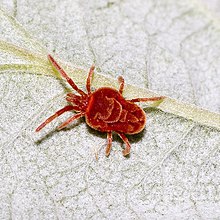
Back خاشيات Arabic خاشيات ARZ Trombidiidae Spanish Samettipunkit Finnish Trombidiidae French रानी कीड़ा Hindi Bársonyatkafélék Hungarian Trombidiidae Italian Fluweelmijten Dutch ସାଧବ ବୋହୂ OR
| Trombidiidae Temporal range:
| |
|---|---|

| |
| Trombidium sp. | |
| Scientific classification | |
| Domain: | Eukaryota |
| Kingdom: | Animalia |
| Phylum: | Arthropoda |
| Subphylum: | Chelicerata |
| Class: | Arachnida |
| Order: | Trombidiformes |
| Superfamily: | Trombidioidea |
| Family: | Trombidiidae Leach, 1815[1] |
Trombidiidae, also known as red velvet mites, true velvet mites,[2] or rain bugs, are small arachnids (eight-legged arthropods) found in plant litter and are known for their bright red color.
While adults are typically no more than 4 mm (0.16 in) in length, some species can grow larger and the largest, including the African Dinothrombium tinctorum and Indian Trombidium grandissimum, may exceed 12 mm (0.47 in).[2][3][4] This also makes them the largest mites, if disregarding ticks engorged after feeding;[5] unlike those, D. tinctorum and T. grandissimum are harmless to humans.[3][4]
Their life pattern is in stages similar to other members of the Prostigmata: egg, pre-larva, larva, protonymph, deutonymph, tritonymph and adult (male or female). They usually have only one breeding cycle per year.[6]
They are active predators as grown adults. As larvae they are often parasites of insects[7] and other arachnids.[8] This lifestyle is typical of the Parasitengona.[9]
One well-known species from Europe, Asia, and North Africa is Trombidium holosericeum.[10] The systematics of this group has been in flux and many former subfamilies of this are now raised to families within the Trombidioidea.[6][11]
- ^ Cite error: The named reference
leach1815was invoked but never defined (see the help page). - ^ a b Cite error: The named reference
bgwas invoked but never defined (see the help page). - ^ a b Maake, P. (2015). "Velvet mites (Family Trombidiidae: Dinothrombium spp.)". ARC-Plant Protection Research. Retrieved 16 July 2023.
- ^ a b De, Sayantan (2020). "Red velvet mite (Trombidium grandissimum) and its extreme strategies for survival". Species. 21 (67).
- ^ Schmidt, J.O.; Schmidt, L.S. (2022). "Big, bad, and red: Giant velvet mite defenses and life strategies (Trombidiformes: Trombidiidae: Dinothrombium)". Journal of Arachnology. 50: 175–180. doi:10.1636/JoA-S-21-019.
- ^ a b Zhang, Zhi-Qiang (1998) Biology and ecology of trombidiid mites (Acari: Trombidioidea) Experimental & Applied Acarology 22:139–155 PDF
- ^ Cite error: The named reference
conradt2002was invoked but never defined (see the help page). - ^ Durkin, Emily S.; Cassidy, Steven T.; Gilbert, Rachel; Richardson, Elise A.; Roth, Allison M.; Shablin, Samantha; Keiser, Carl N. (10 December 2021). "Parasites of spiders: Their impacts on host behavior and ecology". The Journal of Arachnology. 49 (3). doi:10.1636/JoA-S-20-087. ISSN 0161-8202.
- ^ "Parasitengona - velvet mites (including chiggers) & water mites". bugguide.net. Retrieved 3 July 2023.
- ^ Mąkol, J.; Wohltmann, Andreas (2000). "A redescription of Trombidium holosericeum (Linnaeus, 1758) (Acari: Actinotrichida: Trombidioidea) with characteristics of all active instars and notes on taxonomy and biology". Annales Zoologici. 50 (1): 67–91.
- ^ Makol, Joanna (2007) Generic level review and phylogeny of Trombidiidae and Podothrombiidae (Acari: Actinotrichida: Trombidioidea) of the world. Annales Zoologici 57(1): 1–194
© MMXXIII Rich X Search. We shall prevail. All rights reserved. Rich X Search